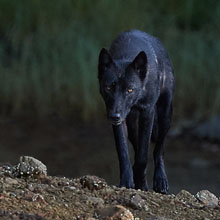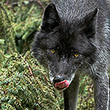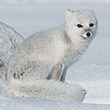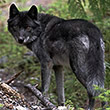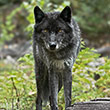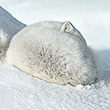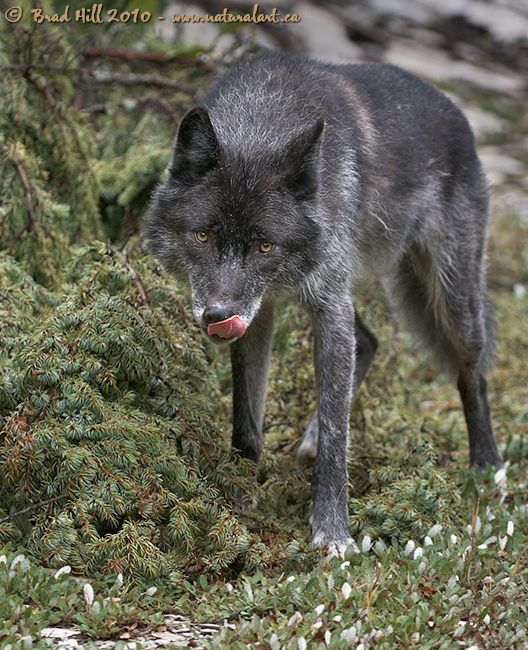
Availability: Undetermined - Enquiries?
In the Field
Hungry Wolf Licking Lips. Red Burn Creek, BC, Canada. August 27, 2004 (image re-processed in early 2010).
One wonders if Little Red Riding Hood viewed a scene similar to this! I managed to catch this adult male Gray Wolf licking his lips along a trail near Golden, BC. Rather than expressing a desire to make me its next meal, this wolf was simply cleaning his face after feeding on some very tasty (at least to the wolf!) fresh meat. Indeed, wolf attacks on humans are exceptionally rare, and there has been only 1 documented fatal attack on a human being in North America in over 100 years. I found the combination of the pink tongue and the intense yellow eyes both visually and emotionally powerful. I feel very fortunate to have temporarily shared a piece of wilderness with such a magnificent creature.
Disclosure of Subject Status: When photographed, this wolf was free-ranging in a natural environment and not restrained in any way. However, it was/is NOT a fully wild wolf - it inhabited a nearby wolf education and rehabilitation centre and was released from captivity shortly before this image was taken. None of the photographs exhibited on this website are of captive animals in zoos or game farms or restrained in any fashion.
Behind the Camera
Hungry Wolf Licking Lips. Red Burn Creek, BC, Canada. August 27, 2004 (image re-processed in early 2010).
Digital Capture; Compressed RAW (NEF) format; ISO 200.
Nikon D2H with with Nikon 70-200mm f/2.8G ED-IF AF-S VR lens @ 155 mm (233 mm equivalent with digital conversion factor) supported on Manfrotto 680B monopod with Really Right Stuff BH-55 ballhead. VR turned to "On" and in "Normal" mode.
1/160s @ f4; -0.3 stop exposure compensation from matrix-metered exposure setting.
At the Computer
Hungry Wolf Licking Lips. Red Burn Creek, BC, Canada. August 27, 2004 (image re-processed in early 2010).
RAW Conversion, including first-pass sharpening, using Phase One's C1 Pro 5.0.2. Two raw conversions at different exposure settings to balance final exposure. Raw conversions at -0.4 stops (to reduce brightness of foreground vegetation and background rocks) through to +0.4 stops (to retrieve shadow detail on portions of the wolf).
All further digital correction on 16-bit TIFF file using Adobe's Photoshop CS4 and Light Craft's LightZone 3.8.5. Photoshop adjustments included compositing (layer and masking) of 2 exposure variants, selective colour saturation and desaturation, and selective sharpening for web output. Final tone tweaking and adjustments using the Tonemapper/Re-light tool of LightZone.
Conservation
Hungry Wolf Licking Lips. Red Burn Creek, BC, Canada. August 27, 2004 (image re-processed in early 2010).
Ten percent of the revenue generated by this image will be donated to Wildsight.
Species Status in Canada*: Only Eastern Wolf listed as species of "Special Concern" in May, 2001. Other populations not listed as Endangered or Threatened.
Species Status in the United States: Western Great Lakes population removed from list of Endangered and Threatened species on January 29, 2007. Proposed delisting of Northern Rockies population on January 29, 2007. Both actions are a direct result of a successful recovery plan. Congratulations! Wolves in other areas of the lower 48 states (including the Southwest wolf population), remain on Endangered Species list.
Probably no species alive today has suffered as much direct persecution from humans as has the Gray Wolf (Canis lupus). Once extremely widespread in North America, the Gray Wolf was virtually extirpated from the contiguous 48 states of America and now is regularly found within only a fraction of its historical range in Canada. While the Gray Wolf is currently listed as endangered in most of the 48 lower states of the United States and enjoys the privileges associated with such status (if lack of persecution and abuse can be thought of as a privilege), it is still official policy in much of Canada to rid the countryside of this magnificent keystone predator. As an example, in British Columbia, there is NO closed season on the wolf in most hunting jurisdictions and opportunistic slaughter is encouraged by policy (it is the ONLY fur-bearing species for which NO hunting license is required in British Columbia!). Conservation of wolves presents a puzzling paradox. Reduced to the most basic principles, wolf conservation is simplistic: we need only to stop persecuting this species in order for it to survive. Yet accomplishing this invariably proves incredibly difficult - it's as though wolf persecution has been institutionalized directly into government (and societal) bureaucracy.
I commend and support those individuals and groups that have the patience and determination to fight for the Gray Wolf. This wolf was photographed in the Columbia Valley of southeast British Columbia. Wildsight is an effective conservation organization that protects biodiversity and promotes sustainable communities in Canada's Columbia and Rocky Mountains. Support for Wildsight, through donation or becoming a member, will help ensure that they remain effective in their efforts to conserve threatened or endangered species and ecosystems.
*as determined by COSEWIC: The Committee on the Status of Endangered Wildlife in Canada


















